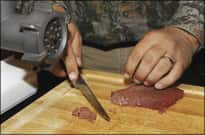Preparation is the Key to Dining on Good Deer in Arkansas
Arkansas Game and Fish Commission 09.12.12

In the coming several weeks, Arkansans will acquire tons – literally –of good meat for the table.
Deer season begins this weekend. And as sure as you mention the topic deer meat, debates will follow on how to handle it.
Let’s narrow down the focus a little. The deer has been killed and processed, properly we hope. Recipes for cooking deer meat are abundant, diversified and readily available on the Internet if you don’t have one handy or a cookbook close by.
A frequent question from someone not experienced in wild game cooking is, “How do I get rid of the gamy taste”? Someone will respond just as quickly, “Why do you want to get rid of the taste? If you want something that tastes like beef, you go to the store and buy some beef.”
Gamy? Call it wild taste to be more precise. Gamy can have a negative meaning also, like the meat isn’t clean or wasn’t cooled properly.
Many people who cook deer meat use a soaking of some sort before getting into the actual preparation. We don’t say this is necessary, but if you want to do it, fine. It won’t hurt anything.
Fresh deer meat can have blood in it, and by soaking a few hours or overnight in a solution like salt water or vinegar and water will remove much of the blood. After the soaking, empty the pan, rinse the meat then proceed. We are using the term soaking here to distinguish it from marinading, but the processes can overlap.
Buttermilk is sometimes used for this purpose, and the theory is that acid in buttermilk helps with the meat like vinegar does.
Experienced wild game cooks know that all deer meat is not the same. Some is more tender than others. Many cooks as well as hunters believe that meat from an older deer will be coarser and tougher than that from a young animal. Some probably can tell by the look and feel of a piece of meat if it will be tender or not.
A suggestion is to soak the meat in solutions of salt and water, vinegar and water or buttermilk if you suspect it could be tough.
Fruit juices can be used as pre-cooking treatments also, but here we are getting more into the marinade process than in the soaking action.
Apple juice goes well with almost any meat – deer or domestic like pork. Cherry juice, pineapple juice and others can be used, and citrus juice – orange, lemon, lime, grapefruit –can be something of a crossover in that the acid can work similar to vinegar and buttermilk.
Soaking and marinading deer meat applies to the various cuts of meat but not to ground deer meat – hamburger. Ground meat doesn’t need the pre-cooking preparation in the view of most wild game cooks, but go ahead and soak the ground meat if you want to. It won’t hurt anything.
Another aspect of the pre-cooking work for deer meat is to tenderize it if you think it needs this.
Some of the best meats from a deer are the backstraps or tenderloins. Slice ‘em thin, then cook ‘em. If you suspect there may be some toughness, a few swats with a meat hammer or the edge of a saucer can help. Most cooks don’t pound the meat to extreme thinness, however.
Experiment if you are not experienced in wild game cooking. Do keep in mind that deer meat is extremely lean meat, and it needs cooking by moist methods for the best results.

